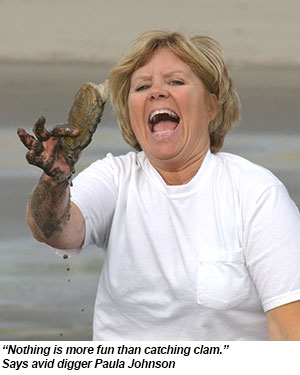So Why No Razor Clams and Yes to
Crab Harvesting?

Clam Diggers at Sunset
Recreational harvest of razor clams is currently closed along the entire Oregon Coast. Many people are wondering when or if the razor clam season will be open. The answer is that it likely won’t be open anytime soon, although other species of shellfish such as mussels, crab and bay clams are open for harvest.
 From the Oregon Department of Fish & Wildlife Website: “Razor clams and other bivalves feed on single celled plants called phytoplankton. Some of these species of phytoplankton manufacture biological toxins that, if ingested, can be stored in the clam. When a “bloom” of phytoplankton occurs, large amounts are consumed. “Although most common in summer months, phytoplankton blooms can occur and cause closures at any time of the year. If warm-blooded animals consume contaminated clams, the stored toxin can be harmful. Symptoms can affect the gastrointestinal and neurological systems.” This is different from Dungeness crab, for example, as crabs do not store the toxin in its meat, but rather in its viscera, or guts, which they are capable of clearing much more quickly.
From the Oregon Department of Fish & Wildlife Website: “Razor clams and other bivalves feed on single celled plants called phytoplankton. Some of these species of phytoplankton manufacture biological toxins that, if ingested, can be stored in the clam. When a “bloom” of phytoplankton occurs, large amounts are consumed. “Although most common in summer months, phytoplankton blooms can occur and cause closures at any time of the year. If warm-blooded animals consume contaminated clams, the stored toxin can be harmful. Symptoms can affect the gastrointestinal and neurological systems.” This is different from Dungeness crab, for example, as crabs do not store the toxin in its meat, but rather in its viscera, or guts, which they are capable of clearing much more quickly.
 “West coast razor clams and other bivalves can be contaminated with the Domoic Acid (DA) toxin. Domoic acid is stored in the necks, gills, digestive systems, muscles and gonadal tissues. Depuration rates (how fast the toxins leave the clam) vary depending upon the biotoxin itself, the level of contamination, the time of year, the species, and the age of the clam. Lower levels can be flushed out in a matter of weeks while high levels may last years.” The ODFW site quotes.
“West coast razor clams and other bivalves can be contaminated with the Domoic Acid (DA) toxin. Domoic acid is stored in the necks, gills, digestive systems, muscles and gonadal tissues. Depuration rates (how fast the toxins leave the clam) vary depending upon the biotoxin itself, the level of contamination, the time of year, the species, and the age of the clam. Lower levels can be flushed out in a matter of weeks while high levels may last years.” The ODFW site quotes.
Domoic acid was first discovered in razor clams in 1991. Razor clams, oysters, crab, and mussels have been sampled routinely on a bi-monthly basis since then. A safety or action level of domoic acid level in clams is 20 parts per million, above which the shellfish are considered unsafe to eat. Domoic acid’s existence is not new, however our knowledge and its effects on consumers is expanding. Symptoms of poisoning can include vomiting, nausea, diarrhea, stomach cramps, headache, dizziness, and short-term memory loss as well as death. The symptoms’ onset is usually between 24 and 48 hours after consumption. Razor clams tend to have higher levels of domoic acid than bay clams, and razors retain the levels for longer. Mussels also can accumulate high levels of DA, but are capable of clearing the toxin within weeks. Algae blooms causing the domoic acid buildup are more typical in the ocean rather than the bay. Freezing, cooking, or any other treatment will not have any effect on the toxin level in the clams.
Click here for more information on Mussel and Clam biotoxin levels.















